 Technology peripherals
Technology peripherals
 AI
AI
 LeCun's new work: layered world model, data-driven humanoid robot control
LeCun's new work: layered world model, data-driven humanoid robot control
LeCun's new work: layered world model, data-driven humanoid robot control
With large models as an intellectual blessing, humanoid robots have become a new trend.
The robot in the science fiction movie "can tell that I am not a human being" seems to be getting closer.
However, it is still a difficult engineering problem for robots, especially humanoid robots, to think and act like humans.
Take a simple learning to walk as an example, using reinforcement learning to train may evolve into the following:

There is no problem in theory (following the reward mechanism), and the goal of going up the stairs has been achieved. Except that the process is relatively abstract and may not be the same as most human behavior patterns.
The reason it is difficult for robots to act "naturally" like humans is due to the high-dimensional nature of the observation and action space, as well as the inherent instability of the bipedal form.
In this regard, a work LeCun participated in provided a new solution based on data-driven.
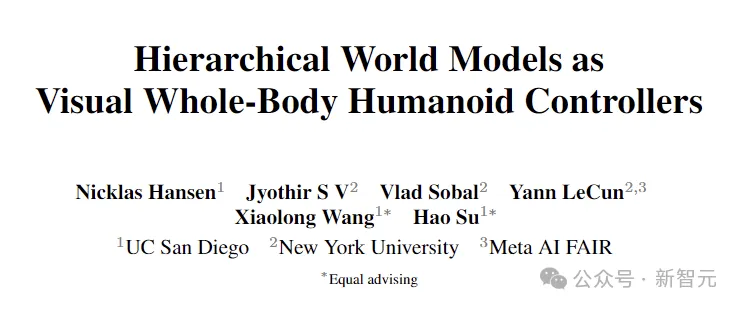
Paper address: https://arxiv.org/pdf/2405.18418
Project introduction: https://nicklashansen.com/rlpuppeteer
Let’s look at the efficacy first:

Compare the effect on the right , the new method trains behavior that is closer to human beings. Although it has a bit of a "zombie" meaning, the abstraction level has been reduced a lot, at least within the capabilities of most humans.
Of course, some netizens who came to cause trouble said, "The one before looked more interesting."

In this work, researchers explore a reinforcement learning-based, highly data-driven, visual full-body humanoid control approach without any simplifications assumptions, reward designs, or skill primitives.
The author proposed a hierarchical world model to train two agents, high-level and low-level. The high-level agent generates commands based on visual observations for execution by the low-level agent.
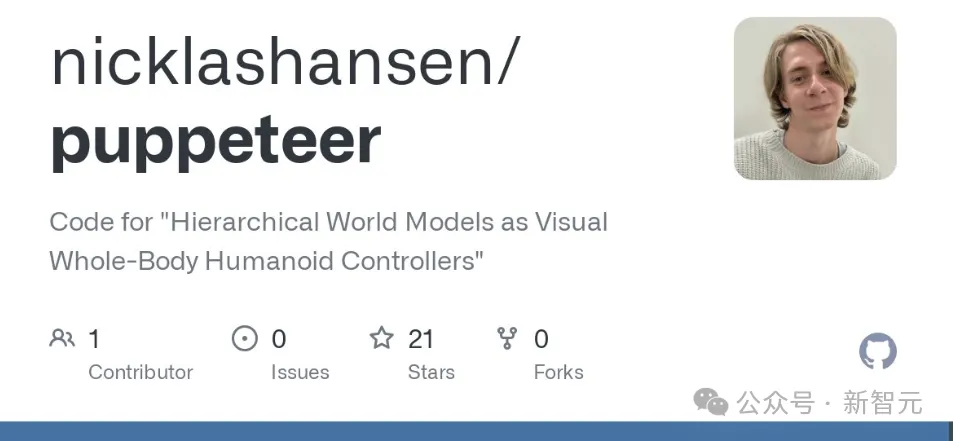
Open source code: https://github.com/nicklashansen/puppeteer
This model is Named Puppeteer, we utilize a simulated 56-DoF humanoid robot to generate high-performance control strategies across eight tasks while synthesizing natural human-like movements and the ability to traverse challenging terrains.

High-dimensional control hierarchical world model
Learning and training general-purpose agents in the physical world has always been AI One of the goals of field research.
Humanoid robots, by integrating full-body control and perception, can perform a variety of tasks and stand out as multi-functional platforms.
But the cost of imitating advanced animals like us is still very high.
For example, in the picture below, in order to avoid stepping into pits, the humanoid robot needs to accurately sense the position and length of the oncoming floor gap, and at the same time carefully coordinate its whole body movements to make it effective. Enough momentum and range to cross every gap.
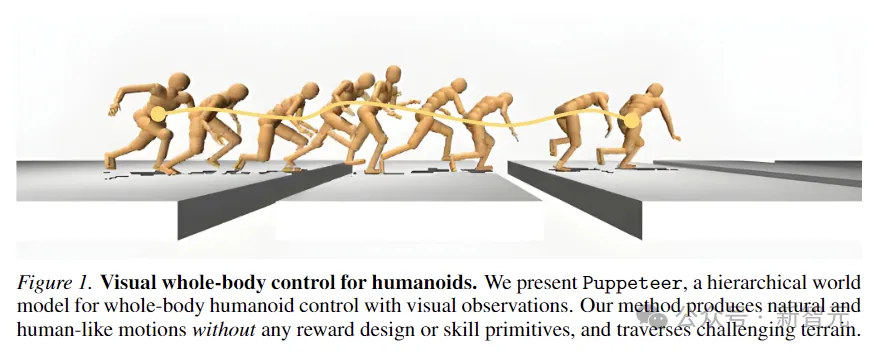
Puppeteer is a data-driven RL method based on the hierarchical JEPA world model proposed by LeCun in 2022.
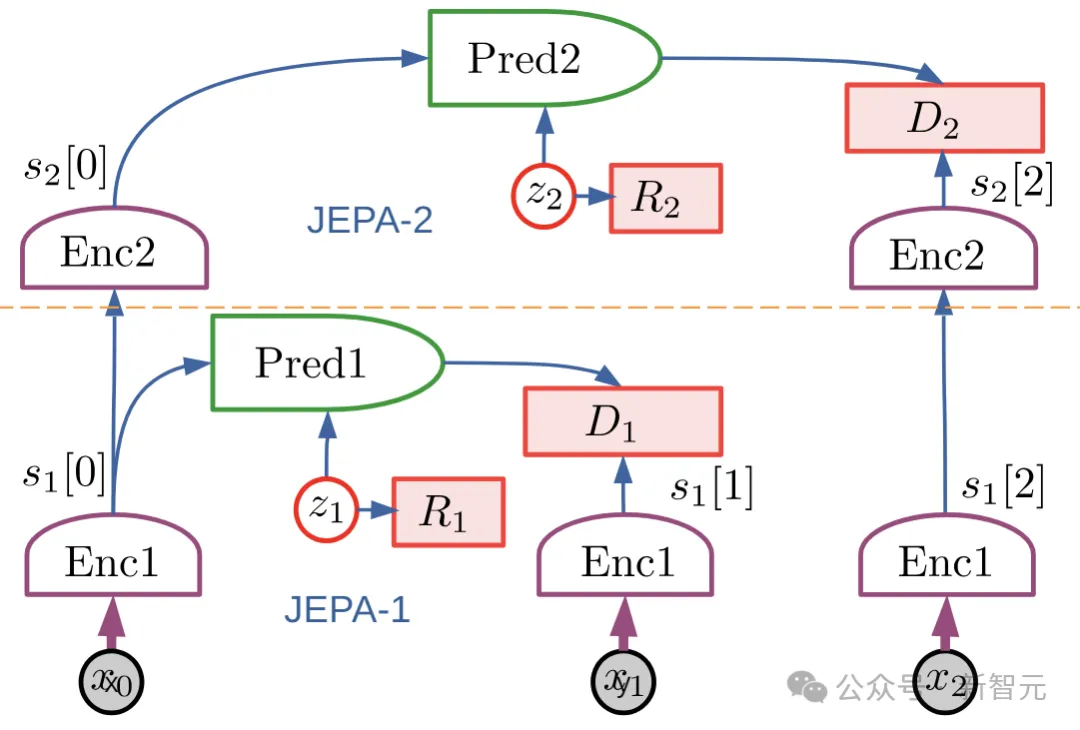
It consists of two different agents: one is responsible for perception and tracking, tracking reference motion through joint-level control; the other "visual puppet" (puppeteer) learns to execute downstream by synthesizing low-dimensional reference motion tasks to provide support for the tracking of the former.
Puppeteer uses the model-based RL algorithm-TD-MPC2 to independently train two agents in two different stages.
(ps: This TD-MPC2 is the animated picture used for comparison at the beginning of the article. Although it seems a bit abstract, it is actually the previous SOTA, published in this year's ICLR, a work Also part of this article)
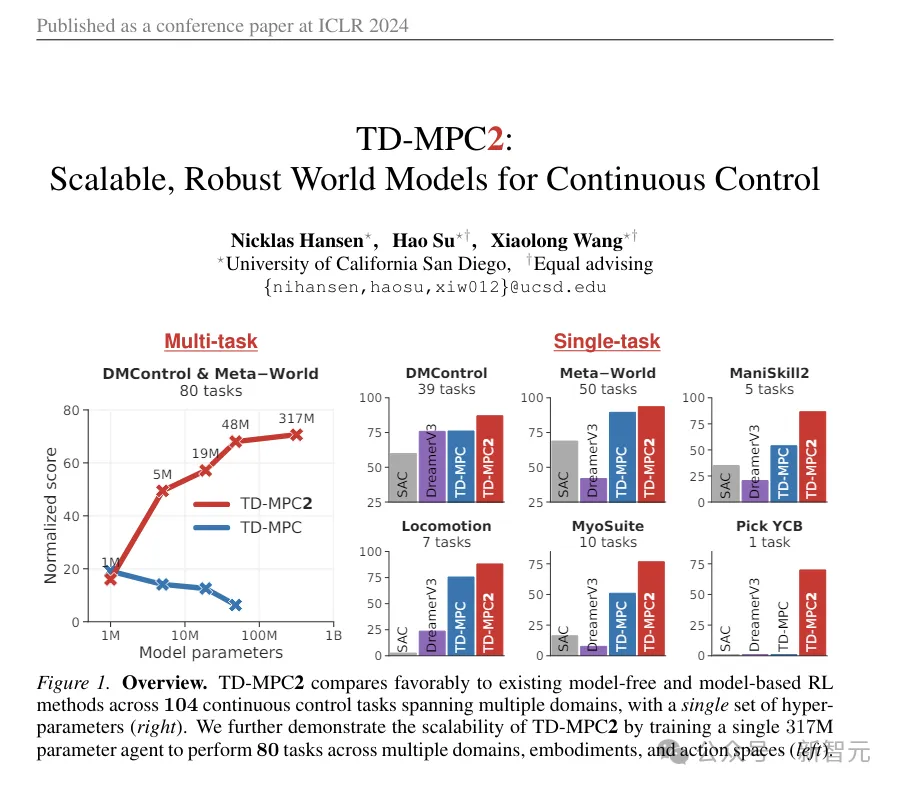
## In the first stage, the world model for tracking is first pre-trained, using pre-existing human actions. Capture data as a reference to convert motion into physically actionable actions. This agent can be saved and reused in all downstream tasks.
In the second stage, a puppet world model is trained, which takes visual observations as input and integrates reference motion provided by another agent as output according to the specified downstream task.
This framework seems simple: the two world models are algorithmically the same, only different in input/output, and are trained using RL without any other bells and whistles thing.
Unlike traditional hierarchical RL settings, "Puppet" outputs the geometric positions of the end-effector joints rather than the embedding of the target.
This makes the agent responsible for tracking easy to share and generalize between tasks, saving the space occupied by the overall calculation.
Research Method
The researchers modeled visual full-body humanoid control as an reinforcement controlled by a Markov decision process (MDP) Learning problem, the process is characterized by tuples (S, A, T, R, γ, Δ),
where S is the state, A is the action, and T is the environment transition function , R is the scalar reward function, γ is the discount factor, and Δ is the termination condition.
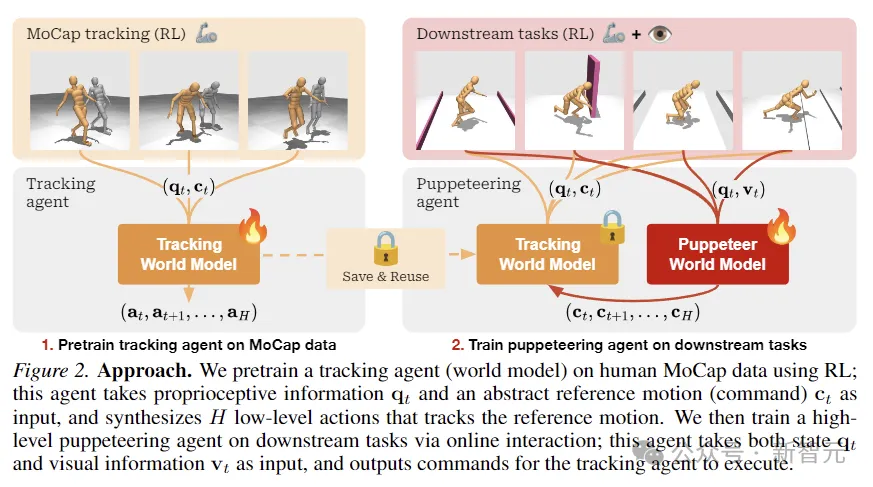
As shown in the figure above, the researchers used RL to pre-train the tracking agent on human MoCap data for obtaining proprioceptive information and abstract reference motion input, and synthesizes low-level actions that track reference motion.
Then through online interaction, the advanced puppet agent responsible for downstream tasks is trained. The puppet accepts status and visual information input and outputs commands for the tracking agent to execute.
TD-MPC2
TD-MPC2 learns a latent decoder-free world model from environment interactions, and use the learned model for planning.
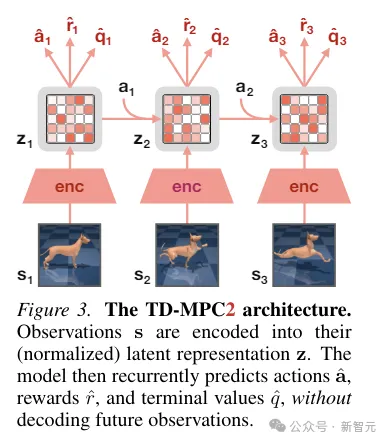
All components of the world model are learned end-to-end using a combination of joint embedding prediction, reward prediction, and temporal difference loss without decoding Original observations.
During inference, TD-MPC2 follows the Model Predictive Control (MPC) framework, using Model Predictive Path Integral (MPPI) as a derivative-free (sampling-based) optimizer for local trajectories optimization.
In order to speed up planning, TD-MPC2 also learns a model-free strategy in advance to pre-start the sampling program.
The two agents are algorithmically identical and both consist of the following 6 components:

Experiment
To evaluate the effectiveness of the method, the researchers proposed a new task suite using a simulated 56-degree-of-freedom humanoid robot for visual full-body control, containing a total of 8 Challenging tasks, methods used for comparison include SAC, DreamerV3 and TD-MPC2.
The 8 tasks are shown in the figure below, including 5 visual-condition whole-body movement tasks, and another 3 tasks without visual input.

Missions are designed with a high degree of randomness and involve running down corridors, jumping over obstacles and gaps, walking up stairs, and around walls.
The five visual control tasks all use a reward function proportional to linear forward speed, while the non-visual tasks reward displacement in any direction.

The above figure plots the learning curve. The results show that SAC and DreamerV3 are unable to achieve meaningful performance on these tasks.
TD-MPC2 performs comparably to this article’s method in terms of rewards, but produces unnatural behavior (see abstract actions in the image below).

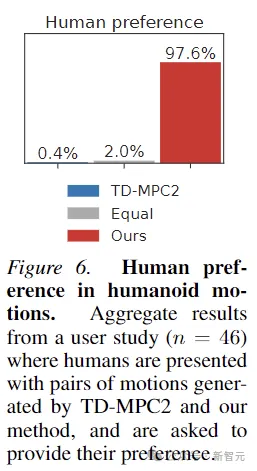
In addition, in order to prove that the actions generated by Puppeteer are indeed more "natural", this article also conducted human preference Experiments with 46 participants showed that humans generally like the motion generated by this method.
The above is the detailed content of LeCun's new work: layered world model, data-driven humanoid robot control. For more information, please follow other related articles on the PHP Chinese website!

Hot AI Tools

Undresser.AI Undress
AI-powered app for creating realistic nude photos

AI Clothes Remover
Online AI tool for removing clothes from photos.

Undress AI Tool
Undress images for free

Clothoff.io
AI clothes remover

Video Face Swap
Swap faces in any video effortlessly with our completely free AI face swap tool!

Hot Article

Hot Tools

Notepad++7.3.1
Easy-to-use and free code editor

SublimeText3 Chinese version
Chinese version, very easy to use

Zend Studio 13.0.1
Powerful PHP integrated development environment

Dreamweaver CS6
Visual web development tools

SublimeText3 Mac version
God-level code editing software (SublimeText3)

Hot Topics
 Which of the top ten currency trading platforms in the world are the latest version of the top ten currency trading platforms
Apr 28, 2025 pm 08:09 PM
Which of the top ten currency trading platforms in the world are the latest version of the top ten currency trading platforms
Apr 28, 2025 pm 08:09 PM
The top ten cryptocurrency trading platforms in the world include Binance, OKX, Gate.io, Coinbase, Kraken, Huobi Global, Bitfinex, Bittrex, KuCoin and Poloniex, all of which provide a variety of trading methods and powerful security measures.
 Recommended reliable digital currency trading platforms. Top 10 digital currency exchanges in the world. 2025
Apr 28, 2025 pm 04:30 PM
Recommended reliable digital currency trading platforms. Top 10 digital currency exchanges in the world. 2025
Apr 28, 2025 pm 04:30 PM
Recommended reliable digital currency trading platforms: 1. OKX, 2. Binance, 3. Coinbase, 4. Kraken, 5. Huobi, 6. KuCoin, 7. Bitfinex, 8. Gemini, 9. Bitstamp, 10. Poloniex, these platforms are known for their security, user experience and diverse functions, suitable for users at different levels of digital currency transactions
 What are the top ten virtual currency trading apps? The latest digital currency exchange rankings
Apr 28, 2025 pm 08:03 PM
What are the top ten virtual currency trading apps? The latest digital currency exchange rankings
Apr 28, 2025 pm 08:03 PM
The top ten digital currency exchanges such as Binance, OKX, gate.io have improved their systems, efficient diversified transactions and strict security measures.
 Decryption Gate.io Strategy Upgrade: How to Redefine Crypto Asset Management in MeMebox 2.0?
Apr 28, 2025 pm 03:33 PM
Decryption Gate.io Strategy Upgrade: How to Redefine Crypto Asset Management in MeMebox 2.0?
Apr 28, 2025 pm 03:33 PM
MeMebox 2.0 redefines crypto asset management through innovative architecture and performance breakthroughs. 1) It solves three major pain points: asset silos, income decay and paradox of security and convenience. 2) Through intelligent asset hubs, dynamic risk management and return enhancement engines, cross-chain transfer speed, average yield rate and security incident response speed are improved. 3) Provide users with asset visualization, policy automation and governance integration, realizing user value reconstruction. 4) Through ecological collaboration and compliance innovation, the overall effectiveness of the platform has been enhanced. 5) In the future, smart contract insurance pools, forecast market integration and AI-driven asset allocation will be launched to continue to lead the development of the industry.
 What are the top currency trading platforms? The top 10 latest virtual currency exchanges
Apr 28, 2025 pm 08:06 PM
What are the top currency trading platforms? The top 10 latest virtual currency exchanges
Apr 28, 2025 pm 08:06 PM
Currently ranked among the top ten virtual currency exchanges: 1. Binance, 2. OKX, 3. Gate.io, 4. Coin library, 5. Siren, 6. Huobi Global Station, 7. Bybit, 8. Kucoin, 9. Bitcoin, 10. bit stamp.
 How to use the chrono library in C?
Apr 28, 2025 pm 10:18 PM
How to use the chrono library in C?
Apr 28, 2025 pm 10:18 PM
Using the chrono library in C can allow you to control time and time intervals more accurately. Let's explore the charm of this library. C's chrono library is part of the standard library, which provides a modern way to deal with time and time intervals. For programmers who have suffered from time.h and ctime, chrono is undoubtedly a boon. It not only improves the readability and maintainability of the code, but also provides higher accuracy and flexibility. Let's start with the basics. The chrono library mainly includes the following key components: std::chrono::system_clock: represents the system clock, used to obtain the current time. std::chron
 How to measure thread performance in C?
Apr 28, 2025 pm 10:21 PM
How to measure thread performance in C?
Apr 28, 2025 pm 10:21 PM
Measuring thread performance in C can use the timing tools, performance analysis tools, and custom timers in the standard library. 1. Use the library to measure execution time. 2. Use gprof for performance analysis. The steps include adding the -pg option during compilation, running the program to generate a gmon.out file, and generating a performance report. 3. Use Valgrind's Callgrind module to perform more detailed analysis. The steps include running the program to generate the callgrind.out file and viewing the results using kcachegrind. 4. Custom timers can flexibly measure the execution time of a specific code segment. These methods help to fully understand thread performance and optimize code.
 How much is Bitcoin worth
Apr 28, 2025 pm 07:42 PM
How much is Bitcoin worth
Apr 28, 2025 pm 07:42 PM
Bitcoin’s price ranges from $20,000 to $30,000. 1. Bitcoin’s price has fluctuated dramatically since 2009, reaching nearly $20,000 in 2017 and nearly $60,000 in 2021. 2. Prices are affected by factors such as market demand, supply, and macroeconomic environment. 3. Get real-time prices through exchanges, mobile apps and websites. 4. Bitcoin price is highly volatile, driven by market sentiment and external factors. 5. It has a certain relationship with traditional financial markets and is affected by global stock markets, the strength of the US dollar, etc. 6. The long-term trend is bullish, but risks need to be assessed with caution.





